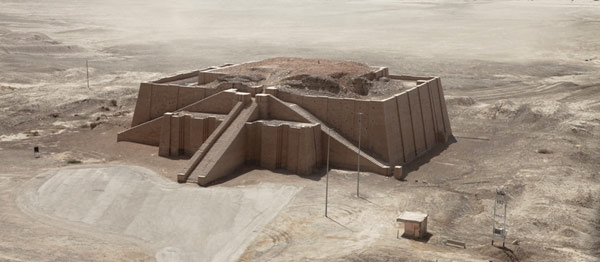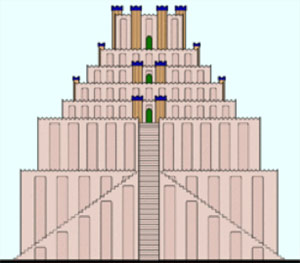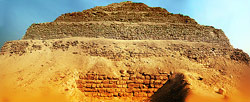
Mesopotamia:
Ziggurats: Connecting Heaven and Earth
Tell el-Mukayyar, Iraq
The ziggurat, the “mountain of God” or “hill of heaven,” was the center of the temple complex. Built of clay bricks, it was a massive, solid, pyramidal stepped structure, the summit of which housed the god. It provided a connection to the heavens and, in practical terms, a place of safety for the priesthood and elite.
Since, in a sense, the role of human beings in Mesopotamia was to be a link between the heavens above and the underworld below, much of the activities of the cities concentrated around the temple area. Temple complexes were built in the center of each city-state and included courtyards, storage rooms, bathrooms, and living quarters. The most important part of the complex was the ziggurat, a massive pyramid-like structure that was the sacred dwelling place of their patron deity and ensured that he/she remained close to them. Additional ziggurats were built for other gods as well.
As the “mountain of God” or “hill of heaven,” ziggurats connected heaven and earth, with the rest of the city-state built around them. During the 48-year reign of King Shugli (2095–2049 BCE), who completed construction of the Ziggurat of Ur, the city of Ur grew to be the capital of a state controlling much of Mesopotamia.

The royal tombs of Ur contained 74 carefully arranged skeletons all entombed at the same time, which implies that monarchs took their staff along with them to the next life. Sir Leonard Woolley (1880–1960), a British archaeologist and an expert in Mesopotamian stories, led a team from the British Museum and University of Pennsylvania to the Sumerian site of Ur. He noted the following:
“Although ten of the Royal Tombs at Ur contained the remains of a central or primary individual, six of them were ‘grave pits’ or ‘death pits’: shafts leading down to the tombs and sunken courtyards built around the tomb or adjacent to it. These were filled with skeletons of retainers, most of them, like their monarchs, dressed in jewels and carrying bowls.
“The largest of these pits was called the Great Pit of Death, located adjacent to Queen Puabi’s tomb and measuring 4 x 11.75 meters. Over seventy individuals were buried there, neatly laid out, wearing jewels and carrying bowls or cups. Bioarchaeological studies of these skeletons show that many of these people had labored hard during their lives, supporting the notion that some of these were servants, even if dressed in finery and perhaps attending a banquet on the last day of their lives.
“Recent CT scans and associated studies of some of the servants’ bodies have revealed that they were killed by blunt force trauma, then preserved with heat and mercury, and later dressed in their finery and laid out in rows for the trip to the afterlife.”
The later Marduk Ziggurat, or Etemenanki, “The Foundation of Heaven and Earth” of Babylon measured 298.48 feet (91 meters) in height with a square base also of 298.48 feet on each side. Exteriors of these temples were often faced with fired bricks glazed with different colors that may have had astrological significance.

Access to the topmost shrine where the god dwelt was provided by a series of ramps on one side of the structure, or by means of a spiral ramp from the base to the summit. Only those of the priesthood were allowed inside and to them was given the responsibility of caring for the god and attending to his or her needs. One practical function of the ziggurats was that they provided a high place on which the priesthood could escape the rising water that annually inundated lowlands and occasionally flooded for hundreds of miles.
Another practical function of the ziggurat was for security. Since the shrine was accessible only by way of stairways, a small number of guards could prevent anyone else but the chosen few from entering the sacred shrine on top.
The trend of the powerful to assume or be awarded god-like stature is one that will show up again and again in our human journey.
The hereditary kings of Babylonia and Assyria were also the chief priests and were regarded as intermediaries between the gods and the people; they were divinely authorized to rule. Says Robert Wright, “According to Mesopotamian cosmology, the universe had once been on the brink of chaos, but fortunately kingship was then invented, which meant that gods who favored order could be rallied to defeat an older generation of gods who didn’t.”
King as God
As kings conquered and absorbed city-states, their gods too were absorbed into each other, with characteristics and qualities merging into a single deity. As monarchs became more and more powerful, one or two began to see himself as a deity. The first ruler who declared himself divine was Naram-Sin of Akkad who reigned sometime during the 23rd century. After Naram-Sin, no ruler declared himself divine for about two centuries, when Shulgi, the second king of the Third Dynasty of Ur, took up the custom of self-deification in an attempt to consolidate the empire he had inherited from his father Ur-Nammu. The trend of the powerful to assume or be awarded godlike stature is one that will show up again and again in our human journey.
External Stories and Videos

Pyramids: Stairway to the Gods
Sally Mallam, Human Journey
Found on at least three continents, pyramids are yet another example of how humans expressed their place in a three-tiered universe.
